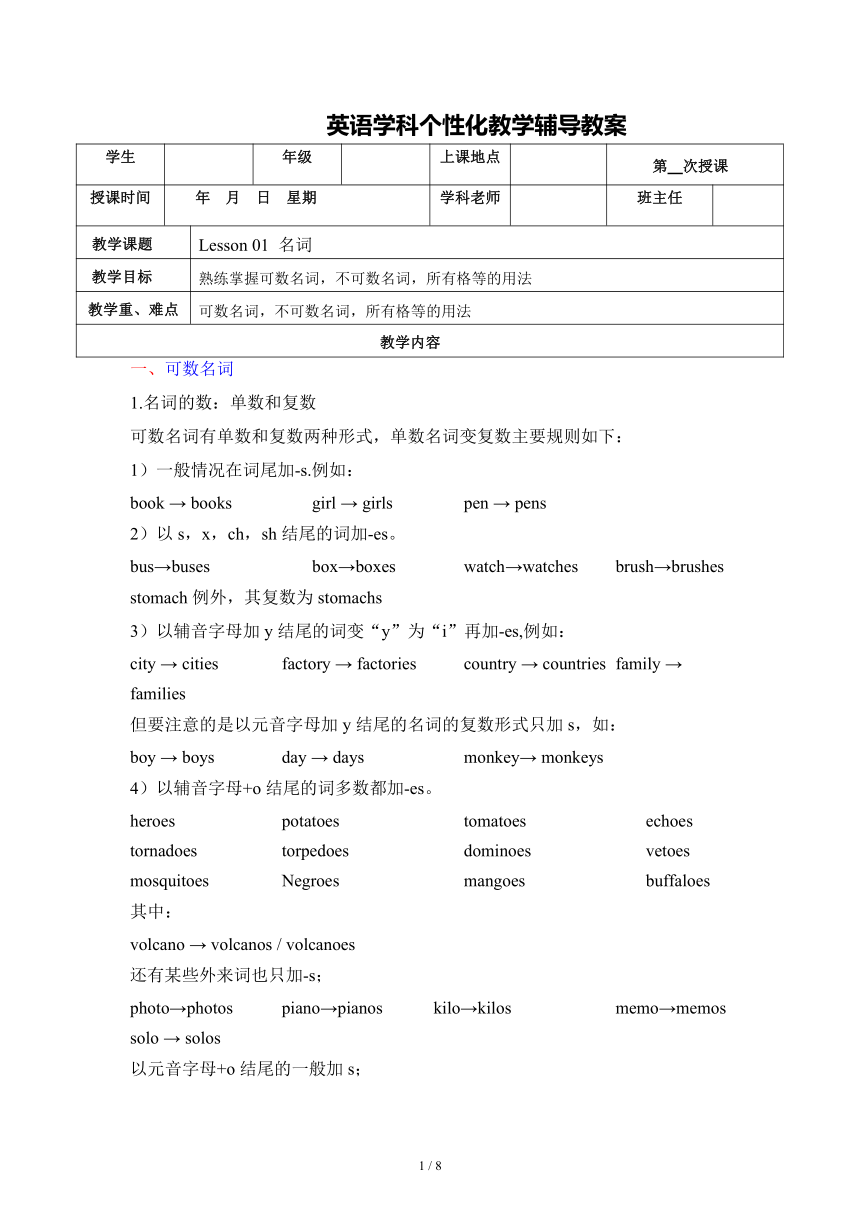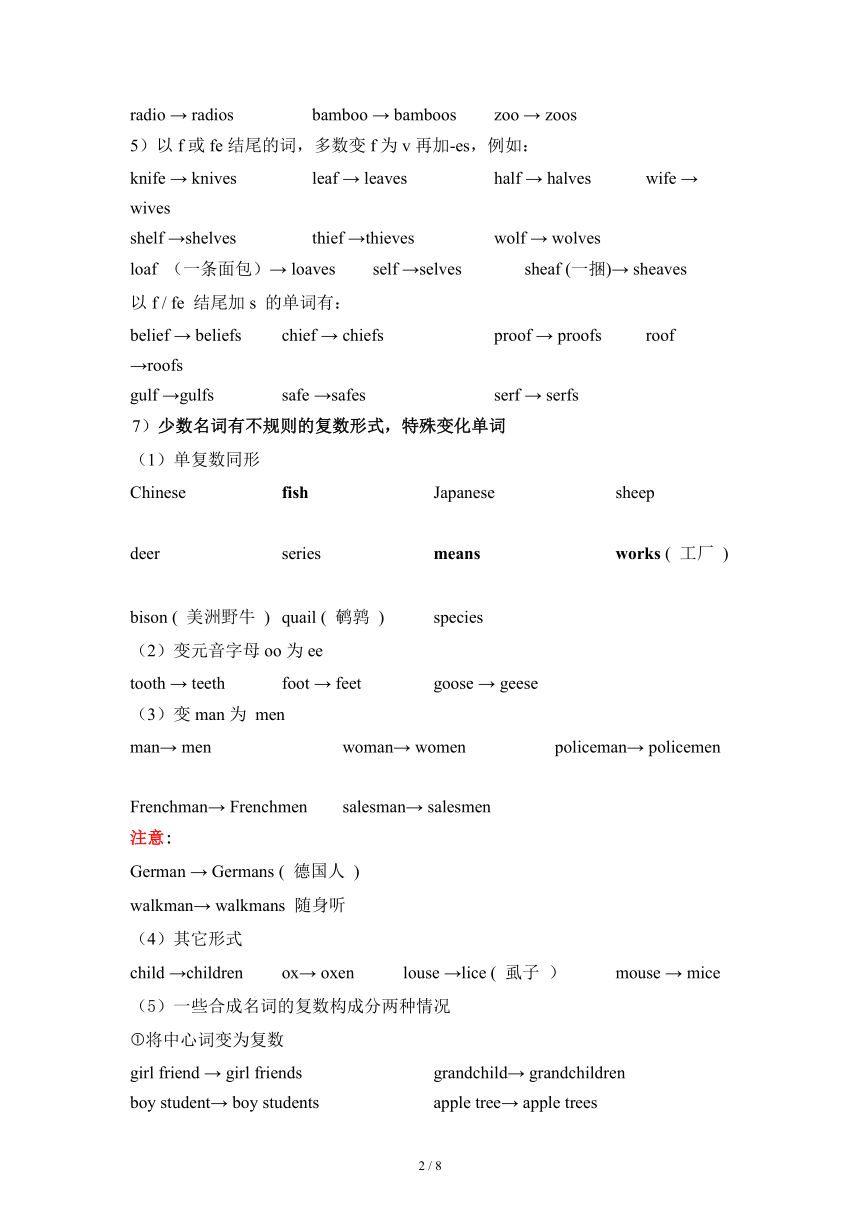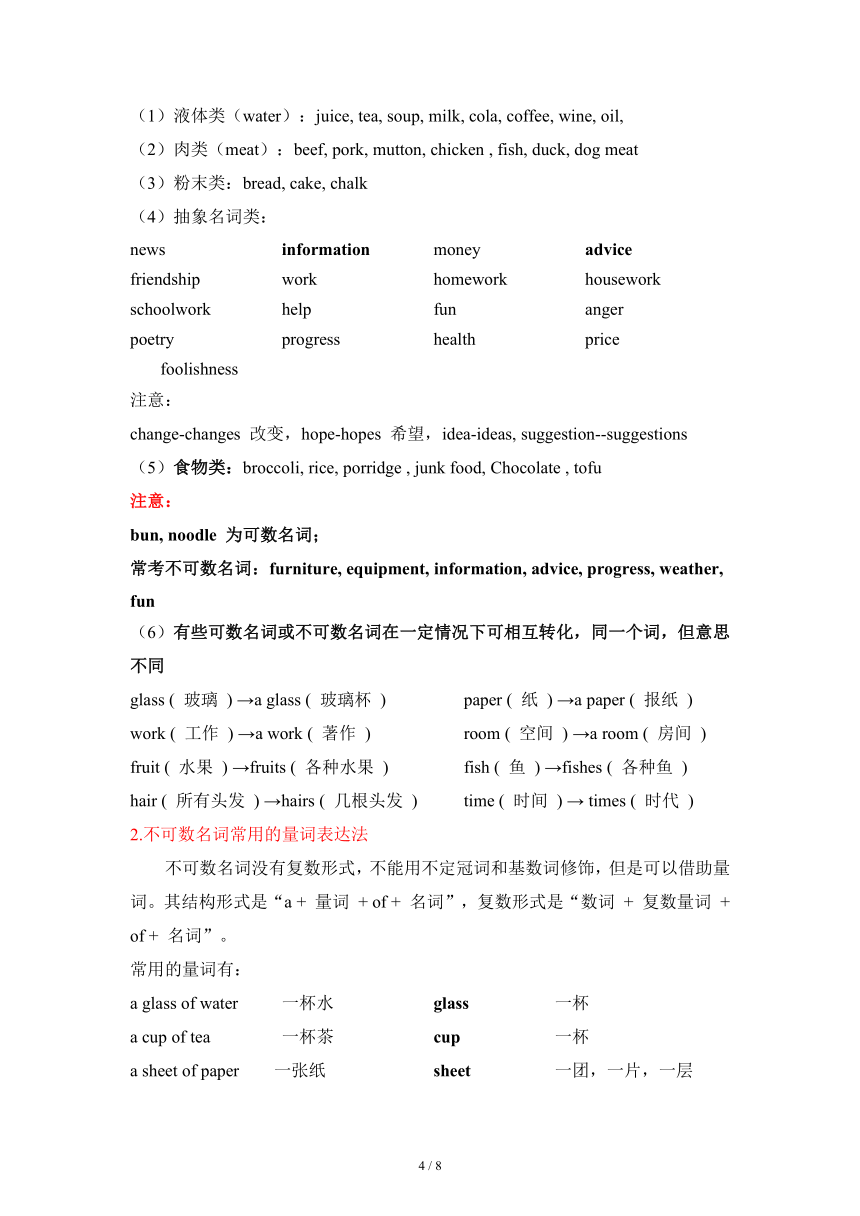2022年中考英语语法专题-第01讲 名词
文档属性
| 名称 | 2022年中考英语语法专题-第01讲 名词 |  | |
| 格式 | docx | ||
| 文件大小 | 44.3KB | ||
| 资源类型 | 教案 | ||
| 版本资源 | 通用版 | ||
| 科目 | 英语 | ||
| 更新时间 | 2022-01-19 19:04:40 | ||
图片预览




文档简介
英语学科个性化教学辅导教案
学生 年级 上课地点 第 次授课
授课时间 年 月 日 星期 学科老师 班主任
教学课题 Lesson 01 名词
教学目标 熟练掌握可数名词,不可数名词,所有格等的用法
教学重、难点 可数名词,不可数名词,所有格等的用法
教学内容
一、可数名词
1.名词的数:单数和复数
可数名词有单数和复数两种形式,单数名词变复数主要规则如下:
1)一般情况在词尾加-s.例如:
book → books girl → girls pen → pens
2)以s,x,ch,sh结尾的词加-es。
bus→buses box→boxes watch→watches brush→brushes
stomach例外,其复数为stomachs
3)以辅音字母加y结尾的词变“y”为“i”再加-es,例如:
city → cities factory → factories country → countries family → families
但要注意的是以元音字母加y结尾的名词的复数形式只加s,如:
boy → boys day → days monkey→ monkeys
4)以辅音字母+o结尾的词多数都加-es。
heroes potatoes tomatoes echoes
tornadoes torpedoes dominoes vetoes
mosquitoes Negroes mangoes buffaloes
其中:
volcano → volcanos / volcanoes
还有某些外来词也只加-s;
photo→photos piano→pianos kilo→kilos memo→memos
solo → solos
以元音字母+o结尾的一般加s;
radio → radios bamboo → bamboos zoo → zoos
5)以f或fe结尾的词,多数变f为v再加-es,例如:
knife → knives leaf → leaves half → halves wife → wives
shelf →shelves thief →thieves wolf → wolves
loaf (一条面包)→ loaves self →selves sheaf (一捆)→ sheaves
以f / fe 结尾加s 的单词有:
belief → beliefs chief → chiefs proof → proofs roof →roofs
gulf →gulfs safe →safes serf → serfs
7)少数名词有不规则的复数形式,特殊变化单词
(1)单复数同形
Chinese fish Japanese sheep
deer series means works ( 工厂 )
bison ( 美洲野牛 ) quail ( 鹌鹑 ) species
(2)变元音字母oo为ee
tooth → teeth foot → feet goose → geese
(3)变man为 men
man→ men woman→ women policeman→ policemen
Frenchman→ Frenchmen salesman→ salesmen
注意:
German → Germans ( 德国人 )
walkman→ walkmans 随身听
(4)其它形式
child →children ox→ oxen louse →lice ( 虱子 ) mouse → mice
(5)一些合成名词的复数构成分两种情况
将中心词变为复数
girl friend → girl friends grandchild→ grandchildren
boy student→ boy students apple tree→ apple trees
bus driver→ bus drivers computer game→ computer games
traffic light→ traffic lights film-goer → film-goers (电影迷)
man, woman 构成的合成词, 每个名词都要变成复数
a man doctor →men doctors a woman teacher→ women teachers
man cook → men cooks a woman doctor → women doctors
将主要部分变为复数
looker-on → lookers-on 旁观者 hanger-on→ hangers-on 食客
mother-in-law→ mothers-in-law岳母 comrade-in-arms→ comrades-in-arms 战友
(6)国家及该国家人
名称 总称(谓语用复数) 一个人 两个人
China 中国人 the Chinese a Chinese two Chinese
Switzerland 瑞士人 the Swiss a Swiss two Swiss
Japan 日本人 the Japanese a Japanese two Japanese
Australia 澳大利亚人 the Australians an Australian two Australians
Russia 俄国人 the Russians a Russian two Russians
Italy 意大利人 the Italians an Italian two Italians
Greece 希腊人 the Greek a Greek two Greeks
France 法国人 the French a Frenchman two Frenchmen
America 美国人 the Americans an American two Americans
India 印度人 the Indians an Indian two Indians
Canada 加拿大人 the Canadians a Canadian two Canadians
Germany 德国人 the Germans a German two Germans
Britain 英国人 the English an Englishman two Englishmen
Sweden 瑞典人 the Swedish a Swede two Swedes
二、不可数名词
1.定义及界定
不可数名词是表示物质和抽象概念的名词,这些名词一般不用不定冠词,也没有复数形式。
不可数名词的识别
(1)液体类(water):juice, tea, soup, milk, cola, coffee, wine, oil,
(2)肉类(meat):beef, pork, mutton, chicken , fish, duck, dog meat
(3)粉末类:bread, cake, chalk
(4)抽象名词类:
news information money advice
friendship work homework housework
schoolwork help fun anger
poetry progress health price foolishness
注意:
change-changes 改变,hope-hopes 希望,idea-ideas, suggestion--suggestions
(5)食物类:broccoli, rice, porridge , junk food, Chocolate , tofu
注意:
bun, noodle 为可数名词;
常考不可数名词:furniture, equipment, information, advice, progress, weather, fun
(6)有些可数名词或不可数名词在一定情况下可相互转化,同一个词,但意思不同
glass ( 玻璃 ) →a glass ( 玻璃杯 ) paper ( 纸 ) →a paper ( 报纸 )
work ( 工作 ) →a work ( 著作 ) room ( 空间 ) →a room ( 房间 )
fruit ( 水果 ) →fruits ( 各种水果 ) fish ( 鱼 ) →fishes ( 各种鱼 )
hair ( 所有头发 ) →hairs ( 几根头发 ) time ( 时间 ) → times ( 时代 )
2.不可数名词常用的量词表达法
不可数名词没有复数形式,不能用不定冠词和基数词修饰,但是可以借助量词。其结构形式是“a + 量词 + of + 名词”,复数形式是“数词 + 复数量词 + of + 名词”。
常用的量词有:
a glass of water 一杯水 glass 一杯
a cup of tea 一杯茶 cup 一杯
a sheet of paper 一张纸 sheet 一团,一片,一层
a cake of soap 一块肥皂 cake 块状或者饼状
a loaf of bread 一条面包 loaf 一条或一块
a bottle of milk 一瓶牛奶 bottle 一瓶
a piece of chalk 一支粉笔 piece 片,块,段,件
a slice of meat 一片肉 slice 片,薄片
a tin of pork 一听猪肉罐头 tin 罐头盒
a grain of sand 一粒沙子 grain 谷粒
a strip of cloth 一条布 strip 条
a lump of sugar 一块方糖 lump 块
a heap of earth 一堆土 heap 堆
a blade of grass 一片草叶 blade 叶片
a cloud of dust 一片灰尘 cloud 团,群,堆
a gust of wind 一阵风 gust 阵
a ton of coal 一吨煤 ton 吨,大量的
三、名词总结
1.名词修饰词
(1)只修饰可数名词的词或词组
a few few many several a ( large ) number of
scores of dozens of many a(n) a great many
a good [great] many后直接跟名词,不用介词of。但是,若其后所接名词有the, these, my等限定词修饰,则要用介词of。
a great many of my friends 我的朋友当中的许多人
(2)只修饰不可数名词的词或者词组
a little little much a great / good deal of
a great/large amount of large amounts of
(3)既可以修饰可数名词也可修饰不可数名词的词或词组
some a lot of lots of a ( large ) quantity of
large quantities of enough plenty of
2.名词的特殊情况
1.常以复数形式出现的名词(单数形式但其意为复数的名词)people, police, cattle, staff
The cattle are in the shed.
The police often come here.
2.部分集体名词既可以作单数(强调整体)也可以作复数(强调成员)
audience观众 class班级 family家庭 crowd群众,大众
group组 committee委员会 team队,组 public公众
crew n.队,组;全体人员,全体船员
3.复数形式表示特别含义
customs海关 times时代 drinks饮料 sands沙滩
spirits心情,心境;情绪 papers文件 manners礼貌 looks外表
brains头脑智力 jeans牛仔裤;工装裤 works著作,工厂 shorts短裤
goods货物 glasses眼镜
4.还有些名词仅有复数形式
(1)表示由两个相连的类似部分组成的事物的名词只用复数形式,如trousers, clothes, chopsticks, glasses, goods, scissors, compasses。
(2)表示问候、祝贺、感谢等的名词用复数, 如:greetings, wishes, congratulations, thanks, ect.
5.以s结尾但不表示复数概念
(1)maths, politics, physics, news等以s结尾,但不表示复数含义。
(2)以复数名词出现的书名、戏剧名、报纸、杂志名、国名等也视为单数,如:The Arabian Nights 一千零一夜, the United States
四、专有名词
专有名词是表示特定的人、地、组织、机构等所特有名称的词。专有名词的第一个字母大写。专有名词主要分为以下几类:
分类 例词
人名、职位 Tony, General Patton, Professor Smith
地名、国名 Europe, New York, China, Russia
时间、节日 May, Sunday, Thanksgiving Day
报刊、杂志 Life《生活周刊》,New York Times 《纽约时报》
单位、团体机构、组织 the Conservative Party保守党,the Associated Press美联社,the UN
注意:
1.专有名词主要分为零冠词专有名词和定冠词专有名词两种。
零冠词专有名词,如Yale University, Beijing Railway Station等,多由“专有名词+普通名词”组成。
定冠词专有名词,如the United States, the Great Wall等,多由“形容词+普通名词”组成。
2.“a + 人名”意为“一个叫……的人”或“……的作品”。如:a Sam 一个叫Sam的人;a Picasso 一幅毕加索的作品。
3.“the +姓氏复数”表示夫妇二人或一家人。如:the Greens格林夫妇/一家。
4.专有名词作主语时,谓语动词常用单数。如:The United States is also a big country.
五、名词的所有格
名词所有格,用来表示人或物的所有,以及所属关系。
1.加’s 或者s’的情况
(1)单数名词或者复数名词不是以s结尾时加’s。
Mary’s book; a student’s room
(2)以s结尾的复数名词只加’,不以s结尾的复数名词要加’s。
the three girls’ father / the children's presents / women's clothes
(3)以s结尾的单数名词,加’s或者’都可以。
my boss' / boss's plan; / James's book / James' book
(4)不定代词后接else时,在else后加’s, 复合名词一般是在最后一个伺候加’s。
sb else’s bag; my brother-in-law’s birthday
(5)表示几个人共有,仅在最后一个人的名字后加’s,表示各自所有时,需在各个名字后加’s。
Mary and Jane’s car ( 她俩人共有的车 ); Mary’s and Jane’s cars ( 她俩各自的车 )
(6)在表示时间、距离、长度、重量、地方等名词的所有格要用’s。
a twenty minutes’ walk ten miles’ journey
a boat’s length two pounds’ weight
today’s newspaper(今天的报纸) China’s hospital
2.无生命名词的所有格则必须用of结构,名词+of+所有者:
a map of China the end of this term
the capital of our country the color of the flowers
3.双重所有格,即of+’s或of+名词性物主代词。
a friend of my father’s; a book of my daughter’s我女儿的一本书
注意:
物主代词不可与 a, an, this, that, these, those, some, any, several, no, each, every, such, another, which等词一起前置,修饰一个名词,而必须用双重所有格。
a, an, +名词+of +名词性物主代词。如:
a friend of mine. Each brother of his.
5.注’s还可以表示某人的家或者某个店铺。
at my aunt’s ( 我阿姨家 ), at the doctor’s ( 诊所 ) At the barber’s, at the tailor’s
学生 年级 上课地点 第 次授课
授课时间 年 月 日 星期 学科老师 班主任
教学课题 Lesson 01 名词
教学目标 熟练掌握可数名词,不可数名词,所有格等的用法
教学重、难点 可数名词,不可数名词,所有格等的用法
教学内容
一、可数名词
1.名词的数:单数和复数
可数名词有单数和复数两种形式,单数名词变复数主要规则如下:
1)一般情况在词尾加-s.例如:
book → books girl → girls pen → pens
2)以s,x,ch,sh结尾的词加-es。
bus→buses box→boxes watch→watches brush→brushes
stomach例外,其复数为stomachs
3)以辅音字母加y结尾的词变“y”为“i”再加-es,例如:
city → cities factory → factories country → countries family → families
但要注意的是以元音字母加y结尾的名词的复数形式只加s,如:
boy → boys day → days monkey→ monkeys
4)以辅音字母+o结尾的词多数都加-es。
heroes potatoes tomatoes echoes
tornadoes torpedoes dominoes vetoes
mosquitoes Negroes mangoes buffaloes
其中:
volcano → volcanos / volcanoes
还有某些外来词也只加-s;
photo→photos piano→pianos kilo→kilos memo→memos
solo → solos
以元音字母+o结尾的一般加s;
radio → radios bamboo → bamboos zoo → zoos
5)以f或fe结尾的词,多数变f为v再加-es,例如:
knife → knives leaf → leaves half → halves wife → wives
shelf →shelves thief →thieves wolf → wolves
loaf (一条面包)→ loaves self →selves sheaf (一捆)→ sheaves
以f / fe 结尾加s 的单词有:
belief → beliefs chief → chiefs proof → proofs roof →roofs
gulf →gulfs safe →safes serf → serfs
7)少数名词有不规则的复数形式,特殊变化单词
(1)单复数同形
Chinese fish Japanese sheep
deer series means works ( 工厂 )
bison ( 美洲野牛 ) quail ( 鹌鹑 ) species
(2)变元音字母oo为ee
tooth → teeth foot → feet goose → geese
(3)变man为 men
man→ men woman→ women policeman→ policemen
Frenchman→ Frenchmen salesman→ salesmen
注意:
German → Germans ( 德国人 )
walkman→ walkmans 随身听
(4)其它形式
child →children ox→ oxen louse →lice ( 虱子 ) mouse → mice
(5)一些合成名词的复数构成分两种情况
将中心词变为复数
girl friend → girl friends grandchild→ grandchildren
boy student→ boy students apple tree→ apple trees
bus driver→ bus drivers computer game→ computer games
traffic light→ traffic lights film-goer → film-goers (电影迷)
man, woman 构成的合成词, 每个名词都要变成复数
a man doctor →men doctors a woman teacher→ women teachers
man cook → men cooks a woman doctor → women doctors
将主要部分变为复数
looker-on → lookers-on 旁观者 hanger-on→ hangers-on 食客
mother-in-law→ mothers-in-law岳母 comrade-in-arms→ comrades-in-arms 战友
(6)国家及该国家人
名称 总称(谓语用复数) 一个人 两个人
China 中国人 the Chinese a Chinese two Chinese
Switzerland 瑞士人 the Swiss a Swiss two Swiss
Japan 日本人 the Japanese a Japanese two Japanese
Australia 澳大利亚人 the Australians an Australian two Australians
Russia 俄国人 the Russians a Russian two Russians
Italy 意大利人 the Italians an Italian two Italians
Greece 希腊人 the Greek a Greek two Greeks
France 法国人 the French a Frenchman two Frenchmen
America 美国人 the Americans an American two Americans
India 印度人 the Indians an Indian two Indians
Canada 加拿大人 the Canadians a Canadian two Canadians
Germany 德国人 the Germans a German two Germans
Britain 英国人 the English an Englishman two Englishmen
Sweden 瑞典人 the Swedish a Swede two Swedes
二、不可数名词
1.定义及界定
不可数名词是表示物质和抽象概念的名词,这些名词一般不用不定冠词,也没有复数形式。
不可数名词的识别
(1)液体类(water):juice, tea, soup, milk, cola, coffee, wine, oil,
(2)肉类(meat):beef, pork, mutton, chicken , fish, duck, dog meat
(3)粉末类:bread, cake, chalk
(4)抽象名词类:
news information money advice
friendship work homework housework
schoolwork help fun anger
poetry progress health price foolishness
注意:
change-changes 改变,hope-hopes 希望,idea-ideas, suggestion--suggestions
(5)食物类:broccoli, rice, porridge , junk food, Chocolate , tofu
注意:
bun, noodle 为可数名词;
常考不可数名词:furniture, equipment, information, advice, progress, weather, fun
(6)有些可数名词或不可数名词在一定情况下可相互转化,同一个词,但意思不同
glass ( 玻璃 ) →a glass ( 玻璃杯 ) paper ( 纸 ) →a paper ( 报纸 )
work ( 工作 ) →a work ( 著作 ) room ( 空间 ) →a room ( 房间 )
fruit ( 水果 ) →fruits ( 各种水果 ) fish ( 鱼 ) →fishes ( 各种鱼 )
hair ( 所有头发 ) →hairs ( 几根头发 ) time ( 时间 ) → times ( 时代 )
2.不可数名词常用的量词表达法
不可数名词没有复数形式,不能用不定冠词和基数词修饰,但是可以借助量词。其结构形式是“a + 量词 + of + 名词”,复数形式是“数词 + 复数量词 + of + 名词”。
常用的量词有:
a glass of water 一杯水 glass 一杯
a cup of tea 一杯茶 cup 一杯
a sheet of paper 一张纸 sheet 一团,一片,一层
a cake of soap 一块肥皂 cake 块状或者饼状
a loaf of bread 一条面包 loaf 一条或一块
a bottle of milk 一瓶牛奶 bottle 一瓶
a piece of chalk 一支粉笔 piece 片,块,段,件
a slice of meat 一片肉 slice 片,薄片
a tin of pork 一听猪肉罐头 tin 罐头盒
a grain of sand 一粒沙子 grain 谷粒
a strip of cloth 一条布 strip 条
a lump of sugar 一块方糖 lump 块
a heap of earth 一堆土 heap 堆
a blade of grass 一片草叶 blade 叶片
a cloud of dust 一片灰尘 cloud 团,群,堆
a gust of wind 一阵风 gust 阵
a ton of coal 一吨煤 ton 吨,大量的
三、名词总结
1.名词修饰词
(1)只修饰可数名词的词或词组
a few few many several a ( large ) number of
scores of dozens of many a(n) a great many
a good [great] many后直接跟名词,不用介词of。但是,若其后所接名词有the, these, my等限定词修饰,则要用介词of。
a great many of my friends 我的朋友当中的许多人
(2)只修饰不可数名词的词或者词组
a little little much a great / good deal of
a great/large amount of large amounts of
(3)既可以修饰可数名词也可修饰不可数名词的词或词组
some a lot of lots of a ( large ) quantity of
large quantities of enough plenty of
2.名词的特殊情况
1.常以复数形式出现的名词(单数形式但其意为复数的名词)people, police, cattle, staff
The cattle are in the shed.
The police often come here.
2.部分集体名词既可以作单数(强调整体)也可以作复数(强调成员)
audience观众 class班级 family家庭 crowd群众,大众
group组 committee委员会 team队,组 public公众
crew n.队,组;全体人员,全体船员
3.复数形式表示特别含义
customs海关 times时代 drinks饮料 sands沙滩
spirits心情,心境;情绪 papers文件 manners礼貌 looks外表
brains头脑智力 jeans牛仔裤;工装裤 works著作,工厂 shorts短裤
goods货物 glasses眼镜
4.还有些名词仅有复数形式
(1)表示由两个相连的类似部分组成的事物的名词只用复数形式,如trousers, clothes, chopsticks, glasses, goods, scissors, compasses。
(2)表示问候、祝贺、感谢等的名词用复数, 如:greetings, wishes, congratulations, thanks, ect.
5.以s结尾但不表示复数概念
(1)maths, politics, physics, news等以s结尾,但不表示复数含义。
(2)以复数名词出现的书名、戏剧名、报纸、杂志名、国名等也视为单数,如:The Arabian Nights 一千零一夜, the United States
四、专有名词
专有名词是表示特定的人、地、组织、机构等所特有名称的词。专有名词的第一个字母大写。专有名词主要分为以下几类:
分类 例词
人名、职位 Tony, General Patton, Professor Smith
地名、国名 Europe, New York, China, Russia
时间、节日 May, Sunday, Thanksgiving Day
报刊、杂志 Life《生活周刊》,New York Times 《纽约时报》
单位、团体机构、组织 the Conservative Party保守党,the Associated Press美联社,the UN
注意:
1.专有名词主要分为零冠词专有名词和定冠词专有名词两种。
零冠词专有名词,如Yale University, Beijing Railway Station等,多由“专有名词+普通名词”组成。
定冠词专有名词,如the United States, the Great Wall等,多由“形容词+普通名词”组成。
2.“a + 人名”意为“一个叫……的人”或“……的作品”。如:a Sam 一个叫Sam的人;a Picasso 一幅毕加索的作品。
3.“the +姓氏复数”表示夫妇二人或一家人。如:the Greens格林夫妇/一家。
4.专有名词作主语时,谓语动词常用单数。如:The United States is also a big country.
五、名词的所有格
名词所有格,用来表示人或物的所有,以及所属关系。
1.加’s 或者s’的情况
(1)单数名词或者复数名词不是以s结尾时加’s。
Mary’s book; a student’s room
(2)以s结尾的复数名词只加’,不以s结尾的复数名词要加’s。
the three girls’ father / the children's presents / women's clothes
(3)以s结尾的单数名词,加’s或者’都可以。
my boss' / boss's plan; / James's book / James' book
(4)不定代词后接else时,在else后加’s, 复合名词一般是在最后一个伺候加’s。
sb else’s bag; my brother-in-law’s birthday
(5)表示几个人共有,仅在最后一个人的名字后加’s,表示各自所有时,需在各个名字后加’s。
Mary and Jane’s car ( 她俩人共有的车 ); Mary’s and Jane’s cars ( 她俩各自的车 )
(6)在表示时间、距离、长度、重量、地方等名词的所有格要用’s。
a twenty minutes’ walk ten miles’ journey
a boat’s length two pounds’ weight
today’s newspaper(今天的报纸) China’s hospital
2.无生命名词的所有格则必须用of结构,名词+of+所有者:
a map of China the end of this term
the capital of our country the color of the flowers
3.双重所有格,即of+’s或of+名词性物主代词。
a friend of my father’s; a book of my daughter’s我女儿的一本书
注意:
物主代词不可与 a, an, this, that, these, those, some, any, several, no, each, every, such, another, which等词一起前置,修饰一个名词,而必须用双重所有格。
a, an, +名词+of +名词性物主代词。如:
a friend of mine. Each brother of his.
5.注’s还可以表示某人的家或者某个店铺。
at my aunt’s ( 我阿姨家 ), at the doctor’s ( 诊所 ) At the barber’s, at the tailor’s
同课章节目录
- 词法
- 名词
- 动词和动词短语
- 动词语态
- 动词时态
- 助动词和情态动词
- 非谓语动词
- 冠词
- 代词
- 数词和量词
- 形容词副词及其比较等级
- 介词和介词短语
- 连词和感叹词
- 构词法
- 相似、相近词比较
- 句法
- 陈述句
- 一般疑问句和否定疑问句
- 特殊疑问句及选择疑问句
- 反意疑问句
- 存在句(There be句型)
- 宾语从句
- 定语从句
- 状语从句
- 主谓一致问题
- 简单句
- 并列句
- 复合句
- 主谓一致
- 主、表语从句
- 名词性从句
- 直接引语和间接引语
- 虚拟语气
- 感叹句
- 强调句
- 倒装句
- 祈使句
- 句子的成分
- 句子的分类
- 题型专区
- 单项选择部分
- 易错题
- 完形填空
- 阅读理解
- 词汇练习
- 听说训练
- 句型转换
- 补全对话
- 短文改错
- 翻译
- 书面表达
- 任务型阅读
- 语法填空
- 其他资料
